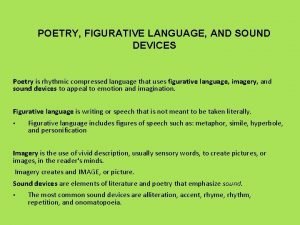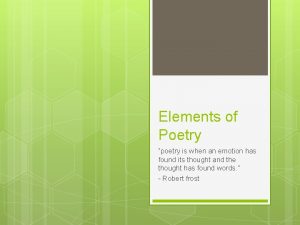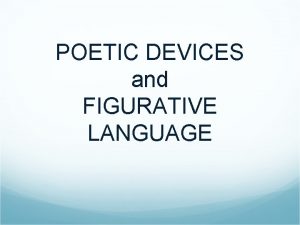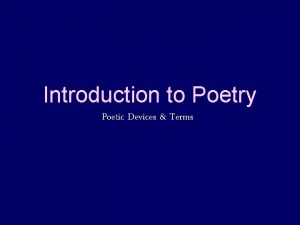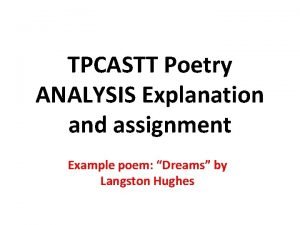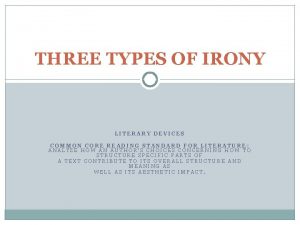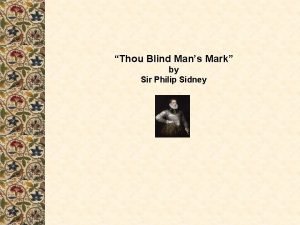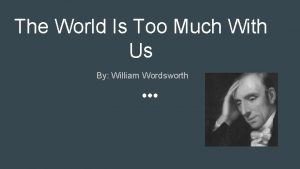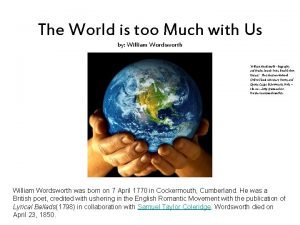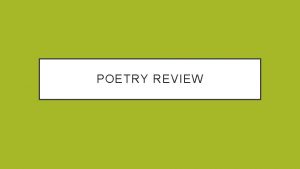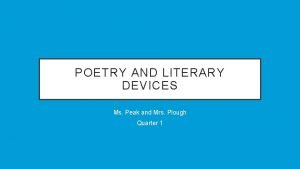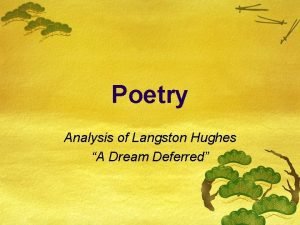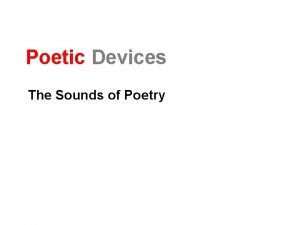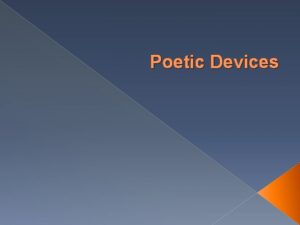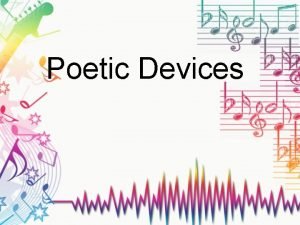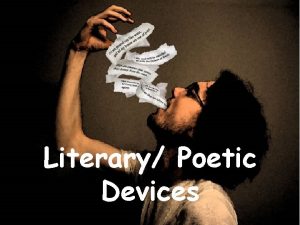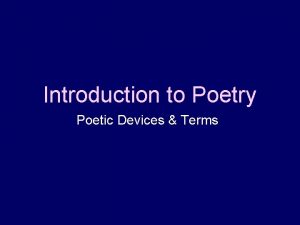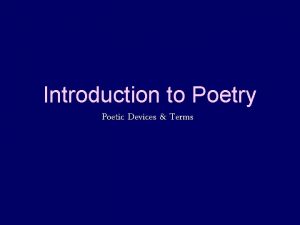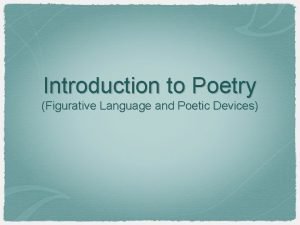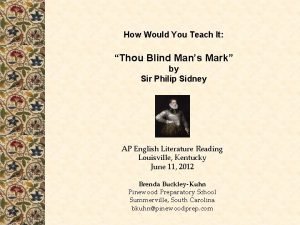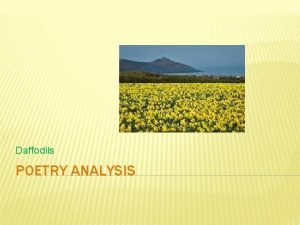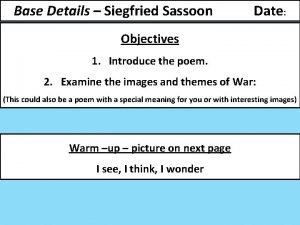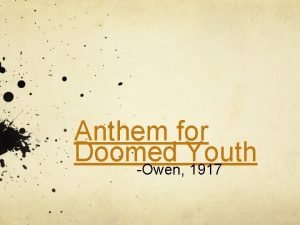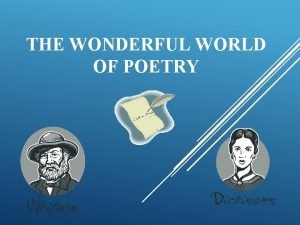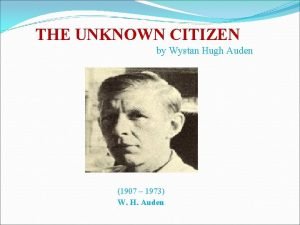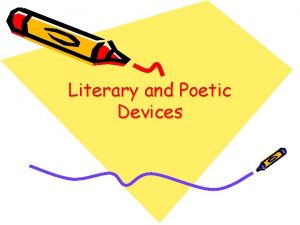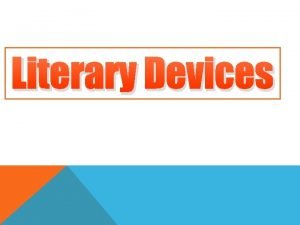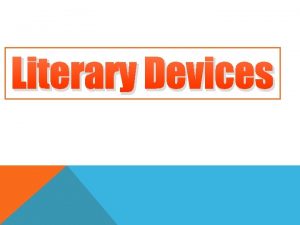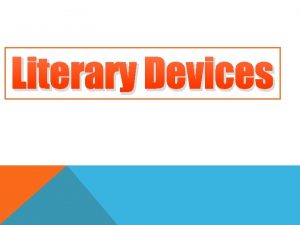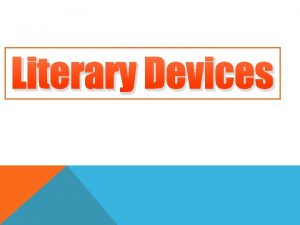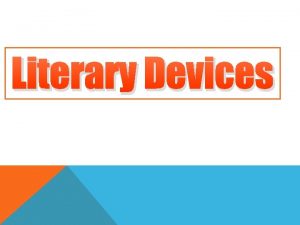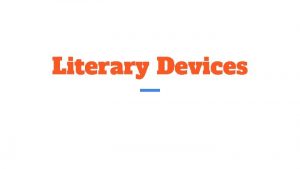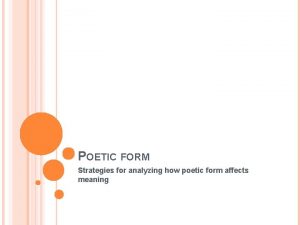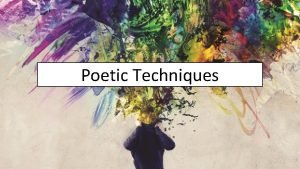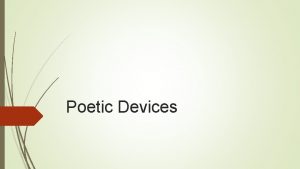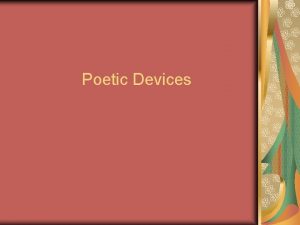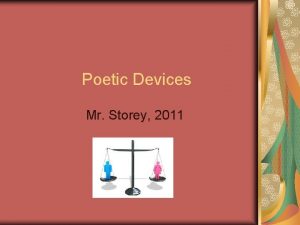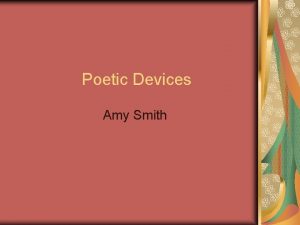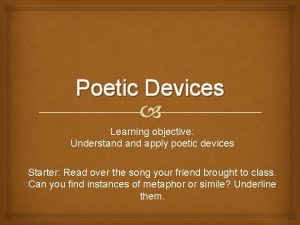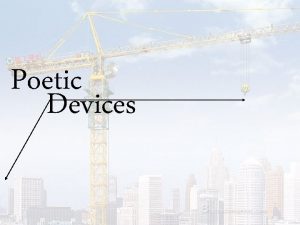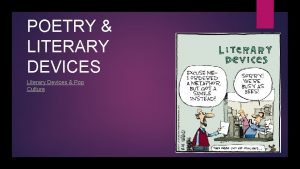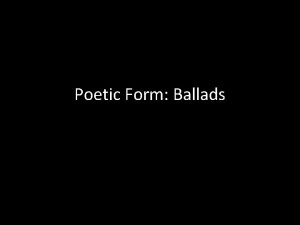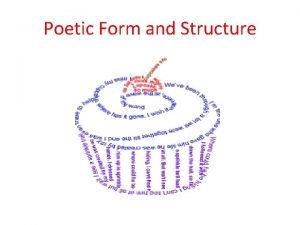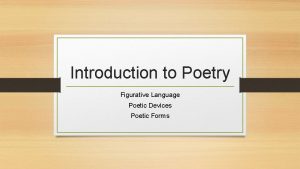Literary and Poetic Devices Literary Devices A form




























- Slides: 28

Literary and Poetic Devices

Literary Devices • A form of language use in which writers and speakers convey something other than the literal meaning of their words. • These are the tools that writers, such as Shakespeare, use to make their writing more complex, deep, and beautiful.

Figurative Language • Language which allows the reader to more clearly and vividly imagine things that are going on in the story. • Examples: • Simile • Metaphor • Personification

Plot • The events that take place in the story. • Exposition/Background, Rising Action, Climax, Falling Action, Resolution/Denoument

Plot

Point of View • The perspective from which the story is told • 1 st person/3 rd person • Limited/omniscient

Character Protagonist Antagonist • The main character/ “good” guy • The “bad” guy/the opposing force or conflict of the story

Setting • The time and place of the story • Multiple • ex. 1960’ s, John’s house, the African jungle, a Puritan era village

Conflict • The problem of the story, the solution that the protagonist must solve • Man vs man (society) • Man vs nature • Man vs. self

Conflict • Internal Conflict – A problem the character is struggling with personally/mentally – Ex. I can’t solve this problem, I don’t have what it takes

Conflict • External Conflict – A problem the character faces which is outside of his/her control – Ex. Another character, nature, physical obstacles

Theme • The lesson the author wants the reader to take away/learn from the story • NOT A 1 WORD IDEA! • Can be argued/has 2 sides • Ex. “Love conquers all” NOT “Love”

Symbol • An object or action in a literary work that means more than itself, that stands for something beyond itself. • Has a deeper meaning • Example: Often, in Shakespeare, birds are a symbol of omens/superstition.

Foreshadowing • Hints of what is to come in the action of a play or a story. • Example: “Fair is foul, and foul is fair. ” • This tells us that the people and actions of this story are not always as simple as they appear to be.

Imagery • The use of one or all of the 5 senses in order to illicit (draw out) an image in the readers mind. • Ex. The sour lemon made his tongue tingle and lips pucker.

Tone • The author or speaker’s attitude toward the subject and the audience. • Ex. Bitter, skeptical, sarcastic

Syntax • The authors choice of sentence structure, the arrangement of words for deliberate purpose

Diction • The author’s word choice • Ex. Using the word “morose” versus “sad”

Allusion • This is a reference within one work of literature (Macbeth) to another person, place, or thing outside of the literature itself (King Edward, Scottish history).

Rhyme • correspondence of sound between words or the endings of words, especially when these are used at the ends of lines of poetry • Ex. Moon, balloon

Simile • A comparison using the words “like” or “as” in the sentence. • Example: “Look like the innocent flower, but be the serpent under it”

Metaphor • A comparison which DOES NOT use the words “like” or “as” in the sentence. • Example: “Your face, my Thane, is a book where men may read strange matters. ”

Personification • Giving human like characteristics to un-human objects or things. • Example: “If chance will have me King, then chance may crown me. ” • Here Chance is being spoken about as if it is a person or character

Alliteration • The repetition of consonant sounds, especially at the beginning of words. • Example: “But now I am cabined, cribbed, confined, bound in to saucy doubts and fears. ” or “The bells, bells”

Consonance • The repetition of consonant sounds for effect • Ex. “all mammals named Sam are clammy"

Assonance • The repetition of vowel sounds for effect • Ex. “He was soon borne away by the waves, and lost in darkness and distance. "

Hyperbole • Extreme exaggeration which the author uses for effect (not meant to be taken literally) • “I’m so hungry I could eat a horse”

Onomatopoeia • the formation of a word from a sound associated with what is named • (e. g. , cuckoo, sizzle, boo )
 Literary techniques vs devices
Literary techniques vs devices What are poetic tools
What are poetic tools Whats a sound device
Whats a sound device Elements in a poem
Elements in a poem Figurative language and poetic devices
Figurative language and poetic devices Repetition in poetry
Repetition in poetry Tpcastt analysis example
Tpcastt analysis example Irony poetic device examples
Irony poetic device examples Thou blind mans mark meaning
Thou blind mans mark meaning Literary devices in the world is too much with us
Literary devices in the world is too much with us Metaphor in the world is too much with us
Metaphor in the world is too much with us Sound devices examples
Sound devices examples Imagery literary device meaning
Imagery literary device meaning A dream deferred by langston hughes analysis
A dream deferred by langston hughes analysis How they clang and clash and roar
How they clang and clash and roar Poetic devices repetition
Poetic devices repetition Introduction to poetry literary devices
Introduction to poetry literary devices Poetic devices repetition
Poetic devices repetition Literary devices
Literary devices Hockey alliteration examples
Hockey alliteration examples Rondeau examples
Rondeau examples Poem with poetic devices highlighted
Poem with poetic devices highlighted Language
Language Thou blind man's mark poem
Thou blind man's mark poem Hyperbole in the poem daffodils
Hyperbole in the poem daffodils Base details notes
Base details notes Anthem for doomed youth techniques
Anthem for doomed youth techniques Figurative language in what a wonderful world
Figurative language in what a wonderful world Auden the unknown citizen
Auden the unknown citizen


